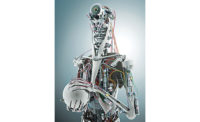Imagine a world where humanoid robots perform a wide range of tasks, including working on assembly lines. This is the world that PAL Robotics SL in Barcelona, Spain, hopes to create. For the past several years, engineers there have designed, programmed and built wheeled and humanoid robots for logistics, retail, service and other applications.
One is the REEM-C, a full-size bipedal humanoid robot. Fully customizable, REEM-C is being researched for applications like human-robot interaction, machine vision, artificial intelligence, grasping and walking.
According to Luca Marchionni, chief technology officer at PAL Robotics, maintaining balance while walking is one of the most difficult challenges for the REEM-C. This is because the robot’s control system has to deal with transition between double-leg support (with both feet on the ground) and single-leg support (when only one foot is planted).
To overcome this problem, PAL engineers use trajectory optimization. This approach involves prescribing an ideal path for the robot, and then calculating the best possible approximation to this path. The engineers must also keep volume and inertia as low as possible, due to the space and weight constraints of the robot’s joints.
All of the joints are fully articulated and capable of performing a range of complex movements—so long as a high-quality encoder provides constant feedback to each joint controller regarding torque, velocity and position. PAL consulted with RLS d.o.o (a Renishaw associate company) on encoder selection, and RLS recommended noncontact magnetic encoders made by Renishaw plc. Rotary AksIM and Orbis encoders are integrated into the robot’s knee, wrist and elbow joints, as well as the component-level incremental RoLin system.
“The encoders have many configurations, [so] it is possible to choose from many different communications protocols, sensor sizes and interfaces,” explains Marchionni. “The more parameters for us the better, [because] we want to make robots that are lighter, more compact and more capable.”
For balance control, a feedback-force system at each robot’s foot is implemented to calculate the zero-moment point (ZMP). The measured ZMP is then fed into a controller to make sure it matches the desired ZMP. This balance controls the instantaneous torque acting on each joint, which enables correct positioning of each robot limb for stable motion.
During walking, rotary encoder feedback ensures precise control of the legs’ joint angles in terms of position, velocity and acceleration. Equally important, encoder outputs enable the estimation of robot posture and the generation of position, speed and acceleration references that every joint should follow.
“To keep balance is a difficult task, as we use reduction gears that introduce some elasticity or non-linearity,” concludes Marchionni. “For us, it’s really important to [accurately] get both the position of the motor and the joint.”
For more information on noncontact magnetic encoders, call 847-286-9953 or visit www.renishaw.com.




